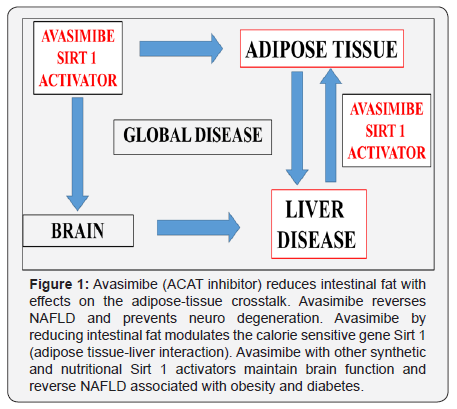Avasimibe and Sirt 1 Activators Reverse NAFLD and Obesity-Juniper Publishers
JUNIPER PUBLISHERS-OPEN ACCESS JOURNAL OF DRUG DESIGNING & DEVELOPMENT
Opinion
In epidemiological studies human obesity is clearly associated with the increased risk for atherosclerosis contributing to the early onset of coronary artery disease and diabetes. Visceral obesity in particular increases the risk of atherosclerosis owing to both insulin resistance and dyslipoproteinemia. Risk factors for atherosclerosis that could be exacerbated by obesity include hypertension and hyper lipidemia particularly hyper triglyceridemia which are risk factors for Alzheimer’s disease. The susceptibility of humans to obesity is far higher compared with other species and in man favours the deposition of fat [1]. Amongst mammals humans have been reported to have the highest level of fatness than any other species and genes and environmental factors predispose humans to obesity [2]. Novel research provides information for anti-aging genes with connections between appetite dysregulation, circadian desynchrony and non alcoholic fatty liver disease (NAFLD) in obesity [3]. Sirtuins are NAD+dependent protein de acetylates that target transcription factors to adapt gene expression to metabolic activity. Sirtuin 1 (Sirt1) is linked to life span, obesity and cardiovascular disease with effects on liver steatosis, inflammation, food intake, energy metabolism, cognition, mitochondrial biogenesis, neurogenesis, glucose/cholesterol metabolism and amyloidosis [3,4]. Regulation by calorie restriction of Sirt1 in extending life span has been recognized with novel dietary activators of Sirt1required [3] that have therapeutic potential for reversal of high fat induced metabolic damage with the prevention of NAFLD [5,6].
The understanding of molecular mechanisms that predispose individuals to obesity may involve high fat diets involved in Sirt 1 repression linked to the defective adipose tissue-liver crosstalk [7-9]. Molecular mechanisms involving diet and drugs that target and reduce the size of the adipose tissue and the development of obesity have become of interest to the biomedical community. The enzyme acyl-coenzyme A: cholesterol acyltransferase 1 (ACAT1) esterifies cholesterol with long-chain fatty acids, and thereby controls the absorption of cholesterol and dietary fat from the intestine [10] that plays an important role in hepatic apo B (cholesterol lipoproteins) and amyloid beta generation [11-14]. The use of ACAT inhibitors such as Avasimibe [15,16] reduce intestinal fatand regulate adipose tissue size to maintain liver ACAT activity and hepatic apo B metabolism [11].
In high fat studies in mice after 6 week mice developed liver steatosis with neuro degeneration [16]. The ACAT inhibitor Avasimibe in mice reduced intestinal fat absorption and reversed fatty liver and neuro inflammation with marked improvement in growth when compared with mice not consuming Avasimibe. An ACAT inhibitor such as Avasimibe (Figure 1) may provide better therapy to maintain the hepatic and brain Sirt1 activity and halt and delay the onset of liver and brain oxidative stress in obesity and other chronic diseases [3]. Avasimibe can be considered as an anti-aging drug that targets the periphery (adipose tissue-liver crosstalk) [7,8] and the brain with relevance to its use with other synthetic Sirt 1activating compounds [17] that require evaluation and assessment in rodent, primate and human trials.
Conclusion
Healthy diets and its therapeutic use in obesity and diabetes may be ineffective with relevance to drug induced mitophagy [18]. Avasimibe and its use with other Sirt 1 activators have become of importance to drug therapy in obesity and diabetes with relevance to the acceleration of hepatic drug metabolism with the prevention of mitochondrial apoptosis [18]. The use of synthetic Sirt 1 activators with healthy diets may prevent brain disease (Figure 1) and NAFLD that are associated with the induction of global obesity linked diabetes [19].

For more Open Access Journals in Juniper Publishers please click on: https://juniperpublishers.com
For more articles in Open Access Novel Approaches in Drug Designing & Development please click on: https://juniperpublishers.com/napdd/index.php
For more Open Access Journals please click on: https://juniperpublishers.com
To know more about Juniper Publishers please click on: https://juniperpublishers.business.site/




Comments
Post a Comment